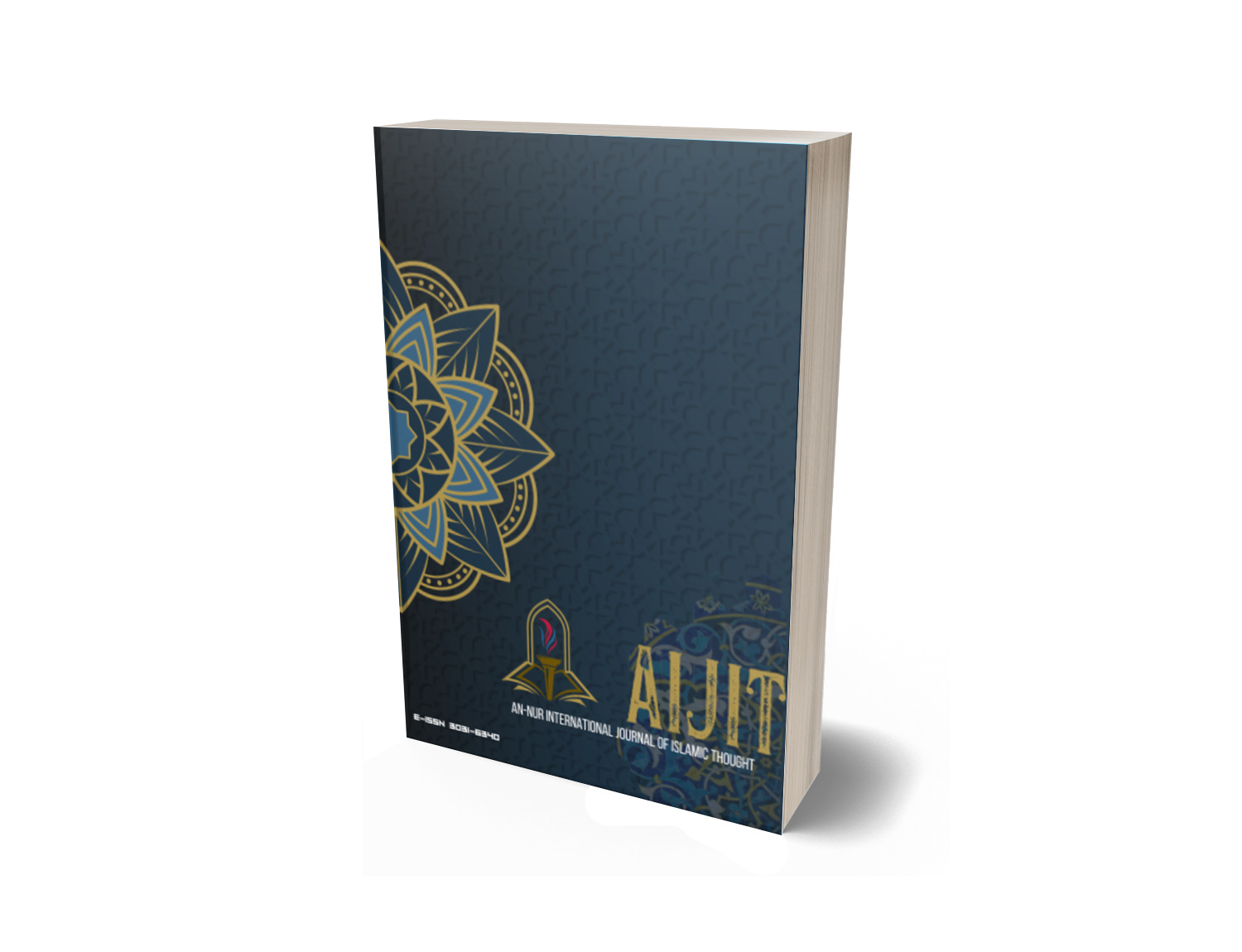The Role of Sufi Networks in Islamic Political and Economic History
Keywords:
Sufism, waqf, poverty and wealth, shrine economy, Islamic governanceAbstract
This paper investigates the multifaceted economic roles and institutional structures of Sufi networks in Islamic societies from medieval to modern times. It examines how Sufi doctrines of poverty and wealth, particularly through the divergent views of al-Ghazālī and Ibn Taymiyyah, shaped a distinctive Islamic economic ethos that intertwined spiritual discipline with ethical material engagement. The study explores the institutionalization of Sufi lodges (khānqāhs and zāwiyas) through waqf endowments, revealing how these centers supported religious transmission, community welfare, and local governance. Sufi lineages such as those in the Safavid and Saʿdī dynasties utilized spiritual charisma and household-based waqf networks to consolidate political authority and social influence. In frontier regions like Bengal and agrarian contexts like Morocco, Sufi institutions catalyzed agricultural development and rural integration, while in urban economies, Sufi guidance permeated trade guilds and artisanal ethics. The study also examines shrine-based pilgrimage economies as enduring engines of spiritual devotion, economic redistribution, and local identity formation, even amid modern state interventions and commodification. By integrating interdisciplinary methodologies from economic anthropology, historical sociology, and religious studies, this research highlights the strategic role of Sufi institutions in negotiating material realities with spiritual commitments. It offers new insights into how Sufi networks cultivated socio-economic resilience, governance structures, and moral economies across diverse Islamic polities and periods.
Downloads
References
Ahmet, T. K. (1994). God’s unruly friends: Dervish groups in the Islamic later middle period 1200-1550. Salt Lake City: University of Utah Press.
Al-Ghazālī, Z. al-D. A. H. M. ibn M. ibn M. ibn A. (2011). Iḥyāʼ ʻulūm al-dīn. Dār al-Minhāj lil-Nashr wa-al-Tawzīʻ.
al-Jawzī, A. al-F. ʻAbd al-R. ibn ʻAlī I. (2018). Talbīs Iblīs. Ārās.
Alam Choudhury, M. (2012). The “impossibility theorems” of Islamic economics. International Journal of Islamic and Middle Eastern Finance and Management, 5(3), 179–202. https://doi.org/10.1108/17538391211255197
Alatas, I. F. (2020). Dreaming saints: exploratory authority and Islamic praxes of history in Central Java. Journal of the Royal Anthropological Institute, 26(1), 67–85. https://doi.org/10.1111/1467-9655.13177
Azdajic, D. (2016). Longing for the Transcendent: The Role of Love in Islamic Mysticism with special reference to al-Ghazālī and Ibn al-ʿArabī. Transformation: An International Journal of Holistic Mission Studies, 33(2), 99–109. https://doi.org/10.1177/0265378815595237
Buehler, A. (1998). Sufi Heirs of the Prophet: The Indian Naqshbandiyya and the Rise of the Mediating Sufi Shaykh. University of South Carolina Press.
Burak-Adlı, F. (2024). The Portrait of an Alla Franca Shaykh: Sufism, Modernity, and Class in Turkey. International Journal Middle East Studies, 56(2), 207–226. https://doi.org/10.1017/s0020743824000631
Chowdury, S. R. H. (2024). Unveiling Sufi Legacies in Dhaka of Bangladesh: A Chronological Discourse on Islamic Heritage. Ulumuna, 28(2), 585–6119. https://doi.org/10.20414/ujis.v28i2.873
Coca, E., Soyer, G., & Ricardo, B. J. (2023). Matopiba’s Disputed Agricultural Frontier: Between Commodity Crops and Agrarian Reform. IDS Bulletin, 54(1). https://doi.org/10.19088/1968-2023.104
Cruz-e-Silva, V., & Cavalieri, M. A. R. (2022). Patterns of interdisciplinary citations and asymmetry between economics and the neighboring social sciences from 1959 to 2018. Nova Economia, 32(1), 261–291. https://doi.org/10.1590/0103-6351/6591
Deweese, D. (2008). The politics of knowledge in premodern Islam: Negotiating ideology and religious inquiry. Journal of the American Academy of Religion, 76, 806. https://doi.org/10.1093/JAAREL/LFN059
Dovel, E. (2017). Gender and Sexuality in Medieval Islamic Mysticism: A Comparative Study of Ibn ‘Arabi and al-Ghazali. American Journal of Undergraduate Research, 14(1). https://doi.org/10.33697/ajur.2017.007
Eigenbrod, F., Beckmann, M., Dunnett, S., Graham, L., Holland, R., Meyfroidt, P., & Verburg, P. (2020). Identifying agricultural frontiers for modeling global cropland expansion. One Earth, 3(4), 504–514. https://doi.org/10.1016/j.oneear.2020.09.006
Elius, M., Khan, I., Mohd Nor, M. R., Muneem, A., Mansor, F., & Yakub @ Zulkifli Bin Mohd Yusoff, M. (2020). Muslim Treatment of Other Religions in Medieval Bengal. Sage Open, 10(4). https://doi.org/10.1177/2158244020970546
Fahrurrozi, M., & Munandar, S. (2024). Zuhud and its application in economic life: Case study of tarikat. Religia, 27(2), 268–284. https://doi.org/10.28918/religia.v27i2.8527
Fernandes, L. (1986). The evolution of a Sufi institution in Mamluk Egypt: The khanqah. Klaus Schwarz Verlag.
Fuad, A. F. N. (2024). NAVIGATING MODERNITY: HAMKAâ€TMS RESPONSES TO THE CHALLENGES OF SECULARISM AND MATERIALISM. Jurnal Penelitian Humaniora, 25(2), 81–90. https://doi.org/10.23917/humaniora.v25i2.23487
Gasimov, K. (2023). Muslim saints contested: Ibn Taymiyya’s critique of al-Qushayrī’s Risāla. Journal of Islamic Studies, 34(2), 153–211. https://doi.org/10.1093/jis/etac045
Göktaş, V., & Chowdury, S. R. H. (2023). Districts of Bangladesh Named After Sufis Manifesting the Great Impact of Sufism on Bengal Civilization: A Qualitative Study. Journal of Islamic Thought and Civilization, 13(1). https://doi.org/10.32350/jitc.131.22
Green, N. (2020). Sufism and the Growth of State Power in Northern India and the Deccan. In The Oxford Handbook of the Mughal World. Oxford University Press. https://doi.org/10.1093/oxfordhb/9780190222642.013.6
HANCOCK, M., & SRINIVAS, S. (2008). Spaces of Modernity: Religion and the Urban in Asia and Africa. International Journal of Urban and Regional Research, 32(3), 617–630. https://doi.org/10.1111/j.1468-2427.2008.00800.x
Hatina, M. (2007). Religious Culture Contested: The Sufi Ritual of Dawsa in Nineteenth-Century Cairo. Die Welt Des Islams, 47(1), 33–62. https://doi.org/10.1163/157006007780331499
Hofer, N. (2015). Popularisation of Sufism in Ayyubid and Mamluk Egypt, 1173-1325. Edinburgh University Press.
Hossain, M. B. (2024). Transformation of Bengal after Arrival of Muslims. Journal of the Asiatic Society of Bangladesh, Humanities, 69(2), 175–201. https://doi.org/10.3329/jasbh.v69i2.78646
Ingram, B. D. (2018). Remaking the Self. In Revival from Below (pp. 116–137). University of California Press. https://doi.org/10.1525/california/9780520297999.003.0005
Ismoilov, L. E. (2023). To the Question of the Theme of Poverty and Prosperity in Late Medieval Sufism (According to the Hagiographic Works “Lamahat min Nafahat al-quds” (“Reflections from the Breath of Holiness”). The Bulletin of Irkutsk State University. Series Political Science and Religion Studies, 45, 156–164. https://doi.org/10.26516/2073-3380.2023.45.156
Jahan Kabir, S. M. N. (2011). Islam, Democracy, and the Question of Coexistence. ICR Journal, 2(3), 501–515. https://doi.org/10.52282/icr.v2i3.628
Kane, O. (2011). The homeland is the arena: Religion, transnationalism, and the integration of Senegalese immigrants in America. Oxford University Press.
Karimov, N., Karimova, R.-B., Massimova, K., & Khajiyeva, G. (2024). Revitalizing Faith: An Inquiry Into Political Sufism and Religious Continuity in Contemporary Kazakhstan. Frontiers in Sociology, 9. https://doi.org/10.3389/fsoc.2024.1447966
KC, K. B., Fraser, E. D. G., Wassmansdorf, D., & Tzadok, E. (2022). Climate change creates opportunities to expand agriculture in the Hindu Kush Himalaya but will cause considerable ecosystem trade-offs. Environmental Research Communications, 4(11), 111001. https://doi.org/10.1088/2515-7620/ac9aea
Khan, K. (2021). Charity in Medieval Sufi Islam: Spiritual Dimensions. International Journal of Linguistics, Literature and Translation, 4(5), 279–286. https://doi.org/10.32996/ijllt.2021.4.5.31
Kim, J. S., Kim, S. T., & Han, J. W. (2024). Spiritual well‐being and restorative experiences: A case of a religious shrine. International Journal of Tourism Research, 26(1). https://doi.org/10.1002/jtr.2625
Lamido, A. A., & Haneef, M. A. (2021). Shifting the paradigms in waqf economics: towards renewed focus on socioeconomic development. Islamic Economic Studies, 29(1), 18–32. https://doi.org/10.1108/IES-04-2021-0014
Latif, M. A. (2024). Sufism and Islam: The Chishtī Sufī Order’s Dynamics. Sophia, 63(4), 869–878. https://doi.org/10.1007/s11841-024-01048-4
Marsot, A. L. A.-S. (1973). The Political and Economic Functions of the “Ulama” in the 18th Century. Journal of the Economic and Social History of the Orient, 16(2/3), 130. https://doi.org/10.2307/3596212
Mohiuddin, A. (2024). Islamism and Globalisation: Unpacking the Dialectics of Ideology and Socio-economic Change in the Middle East. Journal of Globalization Studies, 15(1), 180–198. https://doi.org/10.30884/jogs/2024.01.10
Mokodenseho, S., Paputungan, P., Paputungan, A., Modeong, N., Manggo, T., Kobandaha, S., Dilapanga, S., & Imban, Y. (2024). The Strategic Role of Zakat Management in Socio-Economic Empowerment of the Ummah. West Science Islamic Studies, 2(02), 114–120. https://doi.org/10.58812/wsiss.v2i02.821
Moscatelli, M. (2024). Heritage as a Driver of Sustainable Tourism Development: The Case Study of the Darb Zubaydah Hajj Pilgrimage Route. Sustainability, 16(16), 7055. https://doi.org/10.3390/su16167055
Muhaimin, R., & Iskarim, M. (2024). GERAKAN KEAGAMAAN SEBAGAI PELOPOR TERBENTUKNYA DINASTI SAFAWI DAN KEMAJUAN PENDIDIKAN ISLAM PERSIA. Tarbiyah Islamiyah: Jurnal Ilmiah Pendidikan Agama Islam, 14(1), 57–70. https://doi.org/10.18592/jtipai.v14i1.9740
Muneeza, A., Kunhibava, S., Mohamed, I., & Mustapha, Z. (2025). Empowering the elderly: a cash waqf Takaful model for enhanced provision and protection in Malaysia. International Journal of Islamic and Middle Eastern Finance and Management, 18(1), 68–90. https://doi.org/10.1108/IMEFM-02-2024-0114
Nazori, N., Rafidah, R., Mubyarto, N., Mutia, A., & Rosmanidar, E. (2024). The Role of Sharia-Compliant Financial Institutions in Promoting Economic Stability: Insights from Recent Scholarly Contributions. International Journal of Economics (IJEC), 3(2), 1307–1325. https://doi.org/10.55299/ijec.v3i2.1157
Nompumelelo, L. (2024). Religious Pilgrimages in South Africa: A Catalyst for Sustainable Tourism and Local Economic Development. International Conference on Tourism Research, 7(1), 280–287. https://doi.org/10.34190/ictr.7.1.1969
Noordin, N. H., Haron, S. N., & Kassim, S. (2017). Developing a comprehensive performance measurement system for waqf institutions. International Journal of Social Economics, 44(7), 921–936. https://doi.org/10.1108/IJSE-09-2015-0257
O’Brien, D. B. C. (1990). Nehemia Levtzion and Humphrey J. Fisher (eds.), Rural and Urban Islam in West Africa. Boston & London: Lynne Rienner, 1987, 171 pp., £20.95, ISBN 1 55587 056 2. Africa, 60(1), 172–172. https://doi.org/10.2307/1160449
Ohlander, E. S. (2010). Sufism in Medieval Muslim Societies. History Compass, 8(6), 518–529. https://doi.org/10.1111/j.1478-0542.2010.00683.x
Perveen, S. (2023). SUFI SHRINES AND POLITICS OF NEOPATRIMONIALISM: ANALYSIS SINCE TWENTIETH CENTURY. Pakistan Journal of International Affairs, 6(4). https://doi.org/10.52337/pjia.v6i4.963
Robles‐Ortiz, C. (2020). Frontier Capitalism: Agrarian Expansion in Southern Chile, c. 1890–1930. Bulletin of Latin American Research, 39(2), 238–254. https://doi.org/10.1111/blar.12955
Sabra, A. (2000). Poverty and charity in medieval Islam: Mamluk Egypt, 1250–1517. Cambridge University Press.
Sabra, A. (2010). Household Sufism in sixteenth-century Egypt: The rise of al-Sāda al-Bakriyya BT - Le soufisme à l’époque ottomane, XVIe–XVIIIe siècle (R. Chih & C. Mayeur-Jaouen (eds.); pp. 101–118). Institut Français d’Archéologie Orientale.
Said, I. G., Maram, A. N., & Muhdi, M. (2025). Rethinking Javanese Sufism: From Ascetic Protest to Institutional Power. Teosofi: Jurnal Tasawuf Dan Pemikiran Islam, 15(1 SE-Articles), 113–147. https://doi.org/10.15642/teosofi.2025.15.1.113-147
Saniotis, A. (2012). Attaining the mystical body: Indian Sufi ascetic practices. The Australian Journal of Anthropology, 23(1), 65–83. https://doi.org/10.1111/j.1757-6547.2012.00165.x
Sołjan, I., & Liro, J. (2021). Religious Tourism’s Impact on City Space: Service Zones around Sanctuaries. Religions, 12(3), 165. https://doi.org/10.3390/rel12030165
Sumbal, S. (2016). MIGRANT SUFIS AND SHRINES: A MICROCOSM OF ISLAM INTHE TRIBAL STRUCTURE OF MIANWALI DISTRICT. IJASOS- International E-Journal of Advances in Social Sciences, 2(4), 158. https://doi.org/10.18769/ijasos.66908
Talmud, I. (2007). The Handbook of Economic Sociology. International Sociology, 22(2), 175–178. https://doi.org/10.1177/0268580907074545
Taymiyyah, I. (2025). Perbedaan Wali Allah Yang Keramat & Wali Setan Yang Terlaknat (A. N. Maram (ed.)). PT. Isyraq Annur Media.
Wolper, E. S. (2003). Cities and saints: Sufism and the transformation of urban space in medieval Anatolia. Penn State Press.
Yavuz, M. H. (2005). Islamic political identity in Turkey. Oxford University Press.
Younus, M., & Moosa, E. (2023). Imām Ghazālī: Shakhṣiyat wa Afkār. Fikr-o-Nazar, 60(4), 131–166. https://doi.org/10.52541/fn.v60i4.2680
Published
Issue
Section
License
Copyright (c) 2025 Badrus Sholeh Afi

This work is licensed under a Creative Commons Attribution-ShareAlike 4.0 International License.










